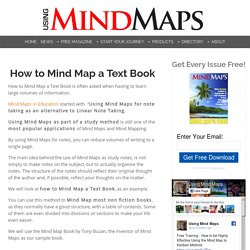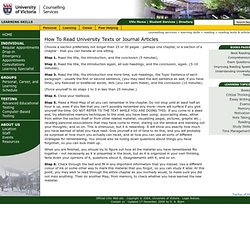

MythBusters: Highlighting helps me study — Psychology In Action. Myth: Highlighting* the textbook will help me study for the test.

As seen in: Used textbooks (paper or digital), Youtube videos and blog posts on how to be a straight A student or how to study better, students exchanging studying tips. Evidence for this: While there is little to no evidence that highlighting text while reading is significantly better than just reading for test performance, some studies have found cases where highlighting may have a slight advantage. For example, Blanchard and Mikkelson (1987) and L. L. Johnson (1988) found that subjects who highlighted text while reading performed better on questions related to the information they highlighted but at a cost of performing worse on questions related to information they did not highlight. Final verdict: Highlighting text is not an effective or reliable way to study for a test. References Blanchard, J., & Mikkelson, V. (1987). Fowler, R. Hayati, A. Johnson, L. Nist, S. Peterson, S. Rickards, J. Textbookstrategies. Are You Reading The Wrong Books? What Science Is Saying About Fiction Readers.
Proper LIT literacysite_belowtitle posted By Will S.

Will S. For most, the love of books starts in childhood. For others, this love blooms later, eventually revealing the vibrant colors of a true bibliophile! But science has started looking into the effects of reading on the brain. I bet all of those are copies are Harry Potter! What has science concluded? In 2012, Standford University did research into why this is. Idea Paper 40 reading. Educational Leadership:Reading: The Core Skill:The Challenge of Challenging Text. Reading Strategies. 3 Digital Reading Challenges for Summer. This summer, more than ever, how we read may be just as important as what we read.

In April, researchers at West Chester University published a report arguing that eReaders could lead to decreased comprehension and fluency. In this New York Times article, the professors suggest that the interactivity, easy access to a dictionary, and constant use of text-to-speech could actually hinder the development of students' reading skills. However, the examples highlighted in the article focus on the content -- comparing traditional, paper-based books to electronic versions with a high level of interactivity such as games and video -- rather than addressing the skills and strategies implemented in the reading process. As I wrote in a previous post, students now have the potential to customize their reading experiences with mobile devices. So this summer, instead of reading in whatever manner you would traditionally use, I'd like to suggest three digital reading challenges. Diigo Features: Being a Better Online Reader.
Soon after Maryanne Wolf published “Proust and the Squid,” a history of the science and the development of the reading brain from antiquity to the twenty-first century, she began to receive letters from readers.

Hundreds of them. Being a Better Online Reader - The New Yorker. Create Ebooks - PapyrusEditor. - Upgrade your KWL Chart to the 21st Century. 0 Comments July 22, 2011 By: Silvia Tolisano Jul 22 Written by: 7/22/2011 12:39 AM ShareThis One of the take aways from the Curriculum Mapping Institute this past week was that it brought an upgrade to THE trusted KWL (Know, What to Know and Learned) Chart to the forefront.

An “H” snuck into the Acronym! What does this “H” stand for”? I started out by searching Google, which immediately wanted to correct my search term and showed me the traditional “KWL chart” results. The top search results turned out mostly downloadable files for templates, which was quiet interesting as there were several explanations in these tutorials what the “H” could stand for: HOW can we find the answers to these questions? In direct relation to our quest to bring Information literacy in the 21st century to our teachers and students, the “HOW will we find the information” sticks out right away for me. My Twitter network was much better in helping me extend my search for KWHL. May 2013 eCampus News.
CCSS & Frustration vs. Instructional Level Texts: Comparing Apples and Oranges. Article Analysis Sheet Guide. How to Mind Map a text book. How to Mind Map a Text Book is often asked when having to learn large volumes of information.

Mind Maps in Education started with "Using Mind Maps for note taking as an alternative to Linear Note Taking. Using Mind Maps as part of a study method is still one of the most popular applications of Mind Maps and Mind Mapping. By using Mind Maps for notes, you can reduce volumes of writing to a single page. The main idea behind the use of Mind Maps as study notes, is not simply to make notes on the subject, but to actually organise the notes. University of Victoria - Counselling Services. Choose a section preferrably not longer than 25 or 30 pages - perhaps one chapter, or a section of a chapter - that you can handle at one sitting.

Step 1. Read the title, the introduction, and the conclusion (5 minutes). Step 2. Read the title, the introduction again, all sub-headings, and the conclusion, again. (5-10 minutes). Step 3.